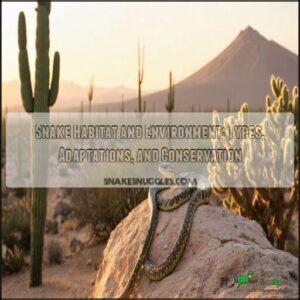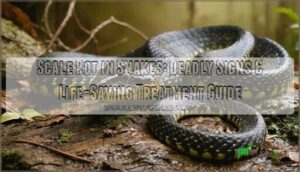This site is supported by our readers. We may earn a commission, at no cost to you, if you purchase through links.
 You’ll find snakes in almost every snake habitat and environment on Earth except Antarctica.
You’ll find snakes in almost every snake habitat and environment on Earth except Antarctica.
They’ve made themselves at home in deserts, rainforests, grasslands, mountains, and even oceans.
Each snake species has adapted perfectly to its surroundings—desert dwellers conserve water like misers, while tree snakes have become nature’s acrobats.
You’ll notice they’re masters of temperature regulation, often basking in morning sun like tourists at a beach resort.
Their homes range from underground burrows to tree hollows, depending on available resources and protection needs.
The connection between a snake’s survival skills and its environment runs deeper than most realize.
Table Of Contents
- Key Takeaways
- Snake Habitat Types
- Snake Environment Adaptations
- Snake Distribution Patterns
- Snake Conservation Status
- Snake Behavior Patterns
- Frequently Asked Questions (FAQs)
- What attracts snakes to the yard?
- What is the best habitat for a snake?
- Where do snakes live in your yard?
- Where are most snakes located?
- How do snakes survive seasonal wildfires?
- Can snakes thrive in polluted environments?
- Do snakes return to previous shelter sites?
- How do snakes adapt to climate change?
- What ecological roles do snakes fulfill?
- Conclusion
Key Takeaways
- You’ll find snakes in nearly every environment on Earth except Antarctica, from scorching deserts to lush rainforests, as they’ve adapted their hunting strategies to thrive in diverse habitats.
- You’re observing masters of adaptation when you see snakes – they regulate body temperature through basking and burrowing, employ sophisticated camouflage techniques, and hibernate (brumate) during harsh winter conditions.
- You’ll notice snakes play crucial ecological roles as both predators and prey, controlling rodent populations in agricultural areas, dispersing seeds, and serving as food for larger animals like hawks and eagles.
- You’re witnessing species under threat when observing snakes today, as habitat destruction, road mortality, climate change, and the illegal pet trade have pushed many species toward endangered status, making conservation efforts increasingly urgent.
Snake Habitat Types
You’ll find snakes living in nearly every type of environment, from scorching deserts to lush rainforests.
Each habitat challenges snakes to adapt in unique ways, shaping their behavior and survival strategies.
Desert Snake Habitats
Desert snake habitats showcase incredible adaptability to arid landscapes.
Snakes thrive in desert ecosystems by burrowing into sand burrows or sheltering among rocky outcrops for temperature regulation.
Desert snakes master the art of survival, turning harsh sands into protective sanctuaries through ingenious burrowing techniques.
Dune ecosystems allow camouflage, while desert geology offers perfect snake dens.
These habitats protect snakes from extreme heat, letting them navigate harsh environments where every grain of sand seems like it’s waiting to test survival.
Tropical Rainforest Habitats
Tropical rainforests burst with life, offering rich reptile habitats.
Snakes thrive in this tropical biodiversity, from forest canopies to rainforest floors.
The dense vegetation and humid climate create perfect snake habitats, supporting their migration and survival.
Rainforest ecology provides ample prey and shelter, making tropical forests ideal for these slithering creatures.
Nature’s balance truly shines in these lush environments, showcasing the tropical biodiversity.
Temperate Forest Habitats
Living in temperate forests, snakes find comfort in shaded areas and the layered underbrush.
They thrive on forest floors, hiding in leaf litter or climbing tree canopies. These woodland areas offer perfect, quiet homes for snakes.
Here’s what makes these forest habitats essential:
- Dense underbrush for camouflage
- Leaf litter for nesting
- Tree canopies for hunting
- Cool temperatures
- Seasonal variation
The combination of these factors creates an ideal environment for snakes, making forest habitats a crucial part of their ecosystem.
Freshwater Habitats
Freshwater habitats, like river ecosystems and lake habitats, offer snakes shelter in wetland areas filled with aquatic plants.
They thrive in aquatic environments where water quality supports diverse prey. Swamp environments provide shade and hunting grounds.
These snakes adapt to aquatic habitats, using camouflage to blend in. Below is a snapshot:
| Habitat Type | Key Feature | Example Species | Threats |
|---|---|---|---|
| River Ecosystems | Flowing water | Water snakes | Pollution |
| Lake Habitats | Still waters | Garter snakes | Habitat loss |
| Wetland Areas | Marshy grounds | Cottonmouths | Development |
| Swamp Environments | Dense vegetation | Nerodia species | Agricultural runoff |
The table highlights the diverse prey and habitat loss associated with different freshwater habitats, emphasizing the importance of preserving these ecosystems for snake populations. Water quality and camouflage are crucial for the survival of snakes in these environments.
Marine Coast Habitats
Snakes living in marine habitats are experts at adapting to coastal ecosystems.
Marine snakes, like sea snakes, flourish in estuary habitats and wetland areas, using saltwater adaptations to thrive.
Shoreline ecology offers rich aquatic habitats for hunting and breeding.
Coastal dunes provide shelter, while snakes navigate marine habitats with unique efficiency, blending seamlessly into shoreline environments teeming with life.
These adaptations are essential for survival in coral reef ecosystems with coral reef habitats, and are a key part of their ability to thrive in marine habitats and saltwater environments.
Snake Environment Adaptations
Snakes are masters of adaptation, using specialized traits to survive in extreme and diverse environments.
You’ll see how they regulate heat, blend in with surroundings, burrow for safety, and even hibernate to endure harsh conditions.
Temperature Regulation
Temperature regulation is the secret weapon snakes use to survive diverse climates.
Their thermoregulation strategies include:
- Basking in sunlight for thermal adaptation.
- Retreating to shade for heat regulation.
- Burrowing underground to escape temperature extremes.
- Using body cryogenesis to endure cold resistance.
- Employing heat-sensing pits for precise climate control.
These techniques help maintain balance in harsh environments.
Understanding thermal sensors technology can provide insights into thermal detection methods, which is crucial for thermal adaptation.
Burrowing Behaviors
Burrowing behavior in snakes showcases their knack for underground navigation. Using digging techniques, some species create sand tunnels or take over existing burrows.
Soil preference impacts burrow depth and stability. For snakes, these shelters serve as refuge from predators and temperature extremes while enabling efficient denning behavior.
They form intricate tunnel networks, offering safe spaces for rest and hibernation. The unique characteristics of burrowing snakes are influenced by their adaptation to underground ecosystems.
| Factor | Description | Example |
|---|---|---|
| Sand Tunnels | Used for hiding, escaping | Desert snakes |
| Burrow Depth | Varies by soil type | Deeper in loose soil |
| Tunnel Networks | Provides multiple routes | Protects from predators |
Camouflage Techniques
Camouflage is a survival masterpiece in snake habitats.
Nature’s invisibility cloak—camouflage lets snakes vanish before your very eyes in their natural habitats.
Their color change and pattern disguise blend them seamlessly into natural environments.
Look for these adaptations:
- Rock Blending: Snakes match rocky terrains.
- Forest Concealment: Patterns mimic light through trees.
- Snake Mimicry: Non-venomous species imitate deadly ones.
- Burrow Camouflage: Sand hues hide desert dwellers.
Each technique guarantees stealthy survival!
Hibernation Patterns
In colder months, many snakes enter brumation, a state like hibernation but less deep.
These dormancy cycles, or torpor states, help snakes survive harsh winters.
Cold adaptation involves finding winter habitats, like underground burrows or rock crevices, for warmth.
Brumation periods often depend on local conditions, with some species thriving in winter denning using ingenious cryogenic adaptations to outlast freezing temperatures in snake habitats, which is crucial for their survival.
Snake Distribution Patterns
You’ll find snakes living almost everywhere on Earth, from dense forests to wide-open grasslands.
They adapt to a variety of environments, excluding only a few regions like Antarctica and Iceland.
Global Distribution
Throughout history, snakes have established their presence on nearly every continent except Antarctica. Their global distribution showcases nature’s incredible adaptability across terrestrial ecosystems.
- Tropical regions offer ideal climate zones for diverse snake species
- Geographic barriers like mountain ranges influence species distribution
- Island colonization has led to high snake endemism rates
- Continental spread varies with some regions remaining snake-free
You’ll find snake habitats spanning diverse geographic isolation conditions worldwide. The absence of native species in some areas can be attributed to island nation geography due to island nation geography and other factors like geographic barriers.
Regional Habitats
Diverse regional habitats sustain snake populations across continents.
You’ll find snakes adapting to mountain ecosystems with specialized scale patterns and in arctic tundras during brief warm seasons.
Savannas and grasslands offer ideal hunting grounds, while wetlands support water-loving species.
These terrestrial ecosystems create unique microhabitats where snakes thrive.
Desert habitats demand water conservation adaptations, and forest habitats provide both arboreal and ground-dwelling options for different snake species, allowing them to occupy a variety of terrestrial ecosystems and unique microhabitats.
Urban Snake Habitats
While regional landscapes vary widely, snakes also thrive in urban environments.
You’ll find urban snake habitats in surprising places where these adaptable reptiles have made their homes alongside humans.
- City parks provide green islands where snakes establish dens under rocks and logs
- Backyard habitats offer shelter in woodpiles, garden borders, and under sheds
- Drainage systems create corridors for urban wildlife movement
Human conflict arises when urban ecology collides with human expectations about habitat distribution.
Effective snake control often involves using an urban snake trap to mitigate these conflicts, particularly in urban environments where snakes are found, and this requires effective snake control to manage human conflict and maintain a balance between humans and urban wildlife.
Agricultural Areas
Agricultural areas offer surprising diversity for snake habitats.
While previous urban settings create unique challenges, farms provide different opportunities for snakes.
| Farm Type | Snake Species | Ecological Role |
|---|---|---|
| Croplands | Garter snakes | Pest control |
| Orchards | Rat snakes | Rodent management |
| Grasslands | Bull snakes | Maintain soil quality |
You’ll find snakes helping with crop management through natural pest control. Their presence indicates healthy farm ecology, though irrigation systems and land use practices can impact their distribution.
Snake Conservation Status
You’ll find many snake species now protected under the Endangered Species Act due to threats like habitat destruction and illegal wildlife trade.
When you help preserve natural habitats and avoid supporting the exotic pet market, you’re directly contributing to snake conservation efforts worldwide.
Endangered Species
Several snake species stand on the brink of species extinction today.
The southern hognose snake, one of North America’s rarest reptiles, is being considered for endangered species protection.
The timber rattlesnake and northern pinesnake face similar challenges to survival.
You’ll find eastern indigo snakes on protected lists as they maintain ecological balance in their habitats.
Wildlife preservation efforts through the IUCN Red List help track biodiversity loss and guide reptile conservation initiatives.
Conservation of the snake’s head and body requires understanding endangered species listings and their impacts.
Threats to Snake Populations
Throughout history, snake populations have faced mounting threats despite their remarkable adaptations.
You’ll find three major challenges endangering these reptiles:
- Road mortality claims thousands of snakes annually as they cross highways
- Human persecution continues due to fear and misunderstanding
- Climate change disrupts hibernation patterns and reduces prey availability
Pollution effects compound these issues, making conservation efforts increasingly urgent for these misunderstood creatures.
Habitat Destruction
Habitat destruction poses the greatest threat to snake populations worldwide. When forests fall and wetlands dry up, snakes lose their homes and hunting grounds. You’ll find snake habitats shrinking as human development expands, making environmental conservation efforts essential for their survival.
| Threat Factor | Impact on Snakes | Conservation Solution |
|---|---|---|
| Deforestation | Eliminates shelter and prey | Protected forest reserves |
| Urbanization | Fragments habitats | Wildlife corridors |
| Agriculture | Destroys natural vegetation | Sustainable farming |
| Climate Change | Alters temperature patterns | Carbon reduction policies |
Illegal Pet Trade
The illegal pet trade threatens countless snake species worldwide.
Rare and colorful specimens fetch premium prices on the black market, fueling wildlife trafficking networks.
When you purchase exotic snakes without proper documentation, you’re potentially supporting animal exploitation.
Many trafficked snakes die during transport, while survivors often face inadequate care in captivity.
Conservation efforts now target these smuggling operations to protect vulnerable species from further population decline.
Snake Behavior Patterns
You’ll notice snakes exhibit fascinating behavioral patterns that range from unique hunting strategies to complex social interactions.
These cold-blooded reptiles adapt their behaviors to their environments, determining when they feed, how they interact with other snakes, and when they’ll migrate to more favorable habitats, which involves complex social interactions and unique hunting strategies.
Hunting Strategies
Snakes employ diverse hunting strategies to capture their prey.
Most species rely on ambush tactics, patiently waiting for unsuspecting victims to approach before striking with lightning speed.
Others actively track prey using heat-sensing pits or chemical trails.
Venomous species deliver toxins through specialized fangs, while constrictors use powerful muscles to squeeze prey.
Camouflage helps these predators avoid detection, enhancing their stealth attacks in various hunting modes, which is a key aspect of their hunting strategies.
Feeding Habits
Beyond hunting tactics, a snake’s feeding behavior reveals fascinating carnivorous adaptations.
You’ll notice these predators have evolved remarkable prey capture techniques that position them effectively in food chains worldwide.
- Jaw flexibility allows swallowing prey much larger than their head
- Digestion periods can last several days or even weeks
- Venom delivery systems vary widely between species
- Diet specialization often reflects their specific habitat
These predator-prey interactions showcase impressive animal adaptations that have developed over millions of years, highlighting the importance of prey capture techniques and feeding behavior in their survival.
Social Interactions
Unlike their feeding habits, most snake species live solitary lives.
You’ll rarely find them in groups except during mating rituals when chemical signals attract potential partners.
Snake communication happens primarily through pheromones and body movements rather than vocalizations.
In certain species, mothers may briefly guard their young after birth.
Territorial defense occurs mainly in resource-rich snake habitats, where individuals establish boundaries against competing snakes through posturing and physical confrontation.
Migration Patterns
While snakes don’t form social groups, they do undertake remarkable seasonal moves. Many species travel between winter hibernation sites and summer feeding grounds, with habitat shifts spanning several miles.
Climate effects trigger these journeys, as you’ll notice snake migration patterns following temperature changes. Geographic range expansion occurs when conditions change, pushing animal distribution into new territories.
Scientists use animal tracking to map these movements, improving our understanding of biogeography and species migration across habitats. The survival of snakes during winter depends on their ability to adapt to cold climate conditions, which is crucial for their winter hibernation and overall species migration patterns, including their habitat shifts.
Frequently Asked Questions (FAQs)
What attracts snakes to the yard?
Your yard attracts snakes when it offers food (rodents, insects), shelter (woodpiles, debris), and water sources. Tall grass, rock piles, and garden mulch provide perfect hiding spots for these reptiles.
What is the best habitat for a snake?
The best snake habitat should mimic their natural environment.
Always research your specific snake species’ requirements for ideal care.
You’ll need appropriate temperature gradients, hiding spots, climbing options for arboreal species, and proper substrate.
Where do snakes live in your yard?
In your yard, snakes typically shelter under rocks, logs, or dense vegetation.
They’ll seek out compost piles, garden beds, and sheds for protection. You’ll find them near water sources and rock walls too.
Where are most snakes located?
You might be surprised to learn snakes aren’t lurking everywhere.
Most snakes are found in tropical regions worldwide, particularly in rainforests.
Although they’ve adapted to deserts, forests, grasslands, and even suburban areas.
How do snakes survive seasonal wildfires?
During wildfires, you’ll find snakes seeking refuge underground in burrows, rock crevices, or moist areas. They can detect temperature changes and vibrations early, allowing them to escape before flames arrive.
Can snakes thrive in polluted environments?
Where there’s poison, there’s adaptation.
Snakes can survive in moderately polluted areas, but persistent contaminants reduce prey availability and can cause health issues.
You’ll find fewer thriving snake populations in heavily polluted environments.
Do snakes return to previous shelter sites?
Many snakes do return to previous shelter sites, especially when they’re reliable.
You’ll often find them reusing burrows, rock crevices, and fallen logs that provided safety and appropriate temperature conditions in the past, making them reliable choices.
How do snakes adapt to climate change?
Climate change impacts snakes dramatically.
You’ll notice they’re shifting their ranges, adjusting hibernation patterns, and changing feeding behaviors.
They’re also altering reproductive timing and seeking microhabitats that provide ideal temperature conditions during extreme weather events.
What ecological roles do snakes fulfill?
Snakes function as both predators and prey in ecosystems.
You’ll find them controlling rodent populations, dispersing seeds through digestion, and serving as food sources for larger animals like hawks, eagles, and mammals.
Conclusion
Ultimately, the writing’s on the wall for snake habitat and environment preservation.
You’ll notice that these remarkable reptiles have carved out niches in every corner of our planet through remarkable adaptations.
Their survival depends on our understanding and protection of their diverse habitats.
By learning about snake habitat and environment needs, you’re taking the first step toward conservation.
Remember, these incredible creatures aren’t just fascinating—they’re essential components of healthy ecosystems worldwide.
- https://nypost.com/2018/12/27/man-finds-writhing-pit-of-30-rattlesnakes-under-abandoned-shed/
- https://www.miragenews.com/from-serpent-abundant-to-snake-free-nations-1098068/
- https://www.sciencedirect.com/science/article/abs/pii/S1055790323001446
- https://www.researchgate.net/publication/334731470_Ecology_of_snakes_on_islands
- https://snakesarelong.blogspot.com/2015/10/


















